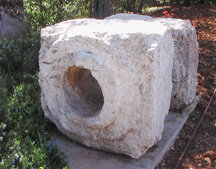Template:Biblical riots
Biblical riots

Herod and the Pharisees with the help of a corrupt Sanhedrin had set up a system of social security where citizens had to pay in as registered members. This system of Legal charity by force would "make the word of God to none effect" and the people wold become human resources for the rulers who called themselves benefactors. This system of Corban offering the wages of unrighteousness would also cause families to breakdown as the primary social unit and curse children as a surety for the debt of the New Deal. It would eventually strangle the hue an cry and divides society rather than bring them together, weaken the poor like the Sin of Sodom, and degenerate individuals into perfect savages.
Even the Greek word korban is related to the term korbanas[1], signifying the “temple treasury.” The Jewish historian Josephus makes it clear that funds from the temple treasury were called “Corban,” hence could not be used for secular purposes, e.g., city improvements, as in the building of an aqueduct for water supply.[2]
The same term is translated treasury in Matthew 27:6, "And the chief priests took the silver pieces, and said, It is not lawful for to put them into the treasury, because it is the price of blood."
Pontius Pilate had put down riots because the Corban. The people's social security money that was kept in the temple treasury was used to build an aqueduct. Despite what people like to think there is no separation of funds in these government treasuries so while Pilate's actions were brutal his position was legally correct.
The structure of Roman society and its government had changed from the original Libera res publica of early Rome. It had moved away from the individual responsibility, charity and trust to practices that instituted force that would degenerate the people into perfect savages. While Polybius predicted this process and Plutarch explained it was Jesus the Christ who taught this other way of thinking. John the Baptist, Jesus and the apostles preached that we should repent and seek the kingdom of God and His righteousness.
We were to turn from the wages of unrighteousness and the Corban of the pharisees and the free bread if Rome and return to the righteous daily ministration of God in the practice of Pure Religion instead of the covetous practices of men who call themselves benefactors but exercise authority one anther. They are not faithful in love for one another for they are biting one another until they are devoured.
2 Peter 2:13 "And shall receive the reward of unrighteousness, [as] they that count it pleasure to riot in the day time. Spots [they are] and blemishes, sporting themselves with their own deceivings while they feast with you;"
What the Bible has tried to tell us is how we structure society with our thinking and our thinking is altered also by the way we structure our society.
- ↑ Korbanas: among the Jews the holy treasury. Pilate spent the holy treasury on an aqueduct and stirred up a riot. It brought in water from a distance of seventy-two kilometers. Bringing in his army, he killed many. From the Suda or Souda a tenth century Byzantine dictionary, which uses ancient sources that have since been lost.
- ↑ "At another time he used the sacred treasure of the temple, called corban (qorban), to pay for bringing water into Jerusalem by an aqueduct. A crowd came together and clamored against him; but he had caused soldiers dressed as civilians to mingle with the multitude, and at a given signal they fell upon the rioters and beat them so severely with staves that the riot was quelled." The Aqueduct- Josephus, War 2.175-177, Antiq 18.60-62.